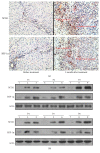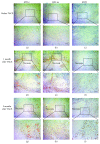Metastasis-Associated Protein 1 Is Involved in Angiogenesis after Transarterial Chemoembolization Treatment
- PMID: 28589145
- PMCID: PMC5447282
- DOI: 10.1155/2017/6757898
Metastasis-Associated Protein 1 Is Involved in Angiogenesis after Transarterial Chemoembolization Treatment
Abstract
Background: Transarterial chemoembolization (TACE), a well-established treatment for unresectable hepatocellular carcinoma (HCC), blocks the arterial blood supply to the tumor, which can be short-lived as development of collateral neovessels, leading to the failure of treatment. Metastasis-associated protein 1 (MTA1) is involved in development of tumors and metastases. However, the role of MTA1 in angiogenesis is still obscure.
Methods: We detected the expression of MTA1 and hypoxia-inducible factor-1α (HIF-1α) and microvessel density (MVD) value in liver tumor tissues and tumor periphery before and after TACE treatment. Hepatocellular carcinoma cell line HepG2, tube formation assay, and chorioallantoic membrane (CAM) assay were applied to explore the mechanism of MTA1 in angiogenesis.
Results: We found that expression of MTA1 increased after TACE treatment, especially in tumor periphery, which was accompanied by markedly elevated MVD value, indicating a significant correlation between MTA1 and MVD value. Moreover, MTA1 contributed to neovascularization of residual tumors. Cellular experiments further revealed that MTA1 increased the stability and the expression of HIF-1α, and overexpression of MTA1 enhanced tube formation and neovessels of chick embryos.
Conclusions: MTA1 is an active angiogenic regulator; our results shed light on better understanding in neovascularization, which are helpful to predict prognosis of TACE, and provide evidences for intervention to improve therapeutic effects on HCC.
Figures






Similar articles
-
Regulation of COX-2 expression and epithelial-to-mesenchymal transition by hypoxia-inducible factor-1α is associated with poor prognosis in hepatocellular carcinoma patients post TACE surgery.Int J Oncol. 2016 May;48(5):2144-54. doi: 10.3892/ijo.2016.3421. Epub 2016 Mar 4. Int J Oncol. 2016. PMID: 26984380 Free PMC article.
-
Andrographolide reduced VEGFA expression in hepatoma cancer cells by inactivating HIF-1α: The involvement of JNK and MTA1/HDCA.Chem Biol Interact. 2017 Aug 1;273:228-236. doi: 10.1016/j.cbi.2017.06.024. Epub 2017 Jun 23. Chem Biol Interact. 2017. PMID: 28651835
-
Single nucleotide polymorphisms associated with metastatic tumour antigen 1 overexpression in patients with hepatocellular carcinoma.Liver Int. 2012 Mar;32(3):457-66. doi: 10.1111/j.1478-3231.2011.02648.x. Epub 2011 Sep 26. Liver Int. 2012. PMID: 22098246
-
Hypoxia and hepatocellular carcinoma: The therapeutic target for hepatocellular carcinoma.J Gastroenterol Hepatol. 2007 Aug;22(8):1178-82. doi: 10.1111/j.1440-1746.2007.04997.x. Epub 2007 Jun 7. J Gastroenterol Hepatol. 2007. PMID: 17559361 Review.
-
Hypoxia and tumor angiogenesis in the era of hepatocellular carcinoma transarterial loco-regional treatments.Future Oncol. 2018 Dec;14(28):2957-2967. doi: 10.2217/fon-2017-0739. Epub 2018 May 1. Future Oncol. 2018. PMID: 29712486 Review.
Cited by
-
Unravelling the Mystery inside Cells by Using Single-Molecule Fluorescence Imaging.J Imaging. 2023 Sep 19;9(9):192. doi: 10.3390/jimaging9090192. J Imaging. 2023. PMID: 37754956 Free PMC article. Review.
-
Metastasis-associated protein 1-mediated antitumor and anticancer activity of dietary stilbenes for prostate cancer chemoprevention and therapy.Semin Cancer Biol. 2022 May;80:107-117. doi: 10.1016/j.semcancer.2020.02.012. Epub 2020 Feb 29. Semin Cancer Biol. 2022. PMID: 32126261 Free PMC article. Review.
-
Metastasis-Associated 1 (MTA1) Gene Expression Promotes Angiogenesis in Mouse Xenografts from Human Non-Small Cell Lung Cancer (NSCLC) Cells.Med Sci Monit. 2019 Jan 17;25:484-491. doi: 10.12659/MSM.912321. Med Sci Monit. 2019. PMID: 30651530 Free PMC article.
-
One-day examination of triple nuclear medicine imaging and application in evaluating transarterial embolization.Heliyon. 2024 Apr 24;10(9):e29597. doi: 10.1016/j.heliyon.2024.e29597. eCollection 2024 May 15. Heliyon. 2024. PMID: 38707399 Free PMC article.
-
MiR-543 promotes tumorigenesis and angiogenesis in non-small cell lung cancer via modulating metastasis associated protein 1.Mol Med. 2020 May 14;26(1):44. doi: 10.1186/s10020-020-00175-1. Mol Med. 2020. PMID: 32410569 Free PMC article.
References
MeSH terms
Substances
LinkOut - more resources
Full Text Sources
Other Literature Sources
Medical
Research Materials
Miscellaneous

